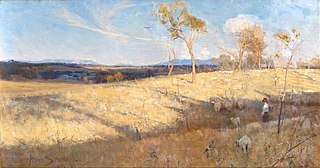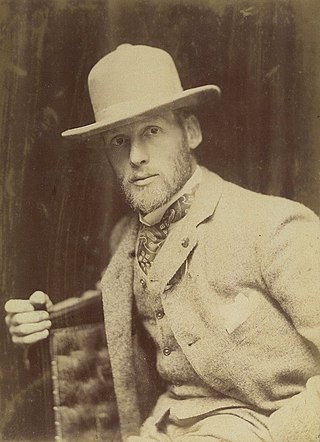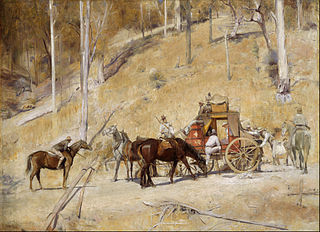| A Break Away! | |
|---|---|
 | |
| Artist | Tom Roberts |
| Year | 1891 |
| Medium | oil on canvas |
| Dimensions | 137.3 cm× 167.8 cm(54.1 in× 66.1 in) |
| Location | Art Gallery of South Australia, Adelaide |
A Break Away! is an 1891 painting by Australian artist Tom Roberts.
| A Break Away! | |
|---|---|
 | |
| Artist | Tom Roberts |
| Year | 1891 |
| Medium | oil on canvas |
| Dimensions | 137.3 cm× 167.8 cm(54.1 in× 66.1 in) |
| Location | Art Gallery of South Australia, Adelaide |
A Break Away! is an 1891 painting by Australian artist Tom Roberts.

The painting depicts a mob of thirsty sheep stampeding towards a dam. A drover on horseback is attempting to turn the mob before they drown or crush each other in their desire to drink. [1] The painting, an "icon of Australian art", is part of a series of works by Roberts that "captures what was an emerging spirit of national identity." [1]
Roberts painted the work at Corowa. [2] The painting depicts a time of drought, with little grass and the soil kicked up as dust. [1] The work itself is a reflection on the pioneering days of the pastoral industry, which were coming to an end by the 1890s. [1] Arthur Streeton recalled years later: "To paint that masterpiece [A break away!], Roberts travelled for six weeks with the drovers." [3]
The painting formed part of the 1898 Exhibition of Australian Art in London, the first major exhibition of Australian art internationally.
A break away! is now part of the collection of the Art Gallery of South Australia having been purchased in 1899. [4] It was included in Quintessence Editions Ltd.'s 2007 book 1001 Paintings You Must See Before You Die. [5]

The Heidelberg School was an Australian art movement of the late 19th century. It has been described as Australian impressionism.
Graham Vivian Sutherland was a prolific English artist. Notable for his paintings of abstract landscapes and for his portraits of public figures, Sutherland also worked in other media, including printmaking, tapestry and glass design.

Thomas William Roberts was an English-born Australian artist and a key member of the Heidelberg School art movement, also known as Australian impressionism.

Sir Arthur Ernest Streeton was an Australian landscape painter and a leading member of the Heidelberg School, also known as Australian Impressionism.

Frederick Ronald Williams was an Australian painter and printmaker. He was one of Australia’s most important artists, and one of the twentieth century's major landscapists. He had more than seventy solo exhibitions during his career in Australian galleries, as well as the exhibition Fred Williams - Landscapes of a Continent at the Museum of Modern Art in New York in 1977.

Philip Wilson Steer was a British painter of landscapes, seascapes plus portraits and figure studies. He was also an influential art teacher. His sea and landscape paintings made him a leading figure in the Impressionist movement in Britain but in time he turned to a more traditional English style, clearly influenced by both John Constable and J. M. W. Turner, and spent more time painting in the countryside rather than on the coast. As a painting tutor at the Slade School of Art for many years he influenced generations of young artists.
Papunya Tula, registered as Papunya Tula Artists Pty Ltd, is an artist cooperative formed in 1972 in Papunya, Northern Territory, owned and operated by Aboriginal people from the Western Desert of Australia. The group is known for its innovative work with the Western Desert Art Movement, popularly referred to as dot painting. Credited with bringing contemporary Aboriginal art to world attention, its artists inspired many other Australian Aboriginal artists and their styles.

1001 Movies You Must See Before You Die is a film reference book edited by Steven Jay Schneider with original essays on each film contributed by over 70 film critics. It is a part of a series designed and produced by Quintessence Editions, a London-based company, and published in English-language versions by Cassell Illustrated (UK), ABC Books, and Barron's (US). The first edition was published in 2003. The most recent edition was published on 14 December 2021. Contributors include Adrian Martin, Jonathan Rosenbaum, Richard Peña, David Stratton, and Margaret Pomeranz.
Carel Victor Morlais Weight, was an English painter.

The Last of England is an 1855 oil-on-panel painting by Ford Madox Brown depicting two emigrants leaving England to start a new life in Australia with their baby. The painting has an oval format and is in the Birmingham Museum and Art Gallery.

Shearing the Rams is an 1890 painting by Australian artist Tom Roberts. It depicts sheep shearers plying their trade in a timber shearing shed. Distinctly Australian in character, the painting is a celebration of pastoral life and work, especially "strong, masculine labour", and recognises the role that the wool industry played in the development of the country.

The 9 by 5 Impression Exhibition was an art exhibition held in Melbourne, Victoria, Australia. It opened on 17 August 1889 at Buxton's Rooms on Swanston Street and featured 183 "impressions", the majority of which were painted by Charles Conder, Tom Roberts and Arthur Streeton, three leading members of the Heidelberg School art movement, also known as Australian impressionism. Two other members, Frederick McCubbin and Charles Douglas Richardson, made smaller contributions.

The Golden Fleece, originally known as Shearing at Newstead, is an 1894 painting by the Australian artist Tom Roberts. The painting depicts sheep shearers plying their trade in a timber shearing shed at Newstead North, a sheep station near Inverell on the Northern Tablelands of New South Wales. The same shed is depicted in another of Roberts' works, Shearing Shed, Newstead (1894).

Bailed Up is a 1895 painting by Australian artist Tom Roberts. The painting depicts a stage coach being held up by bushrangers in an isolated, forested section of a back road. The painting is part of the collection of the Art Gallery of New South Wales. and has been described by one former Senior Curator as "the greatest Australian landscape ever painted".

Sir Sidney Robert Nolan was one of Australia's leading artists of the 20th century. Working in a wide variety of media, his oeuvre is among the most diverse and prolific in all of modern art. He is best known for his series of paintings on legends from Australian history, most famously Ned Kelly, the bushranger and outlaw. Nolan's stylised depiction of Kelly's armour has become an icon of Australian art.
Eileen Yaritja Stevens was an Aboriginal artist from central Australia. Although she had brief career of less than four years, she quickly became one of the most successful artists of her generation to paint in the style of the Western Desert. Her work is now held in several major public art collections across Australia.
Wingu Tingima was an Aboriginal artist from central Australia. She was born in Great Victoria Desert, and grew up living a traditional way of life in the bush, without any contact with Western civilization. A member of the Pitjantjatjara people, she painted spiritual stories from her Dreaming. Along with her friend and colleague Eileen Yaritja Stevens, Wingu became one of the most well-known artists to paint in the style of the Western Desert.
Tjungkara Ken is a Pitjantjatjara artist from Amata, South Australia, in the APY lands. She began painting in 1997, when Minymaku Arts was opened by the women of Amaṯa. She started painting professionally in 2008. By that time, the artists' co-operative had been renamed Tjala Arts.
Nura Rupert was an Australian Aboriginal artist from north-west South Australia. She was also a ngangkari until her death in 2016. She produced two primary kinds of art works. She produced her print works using intaglio methods of printmaking. The designs are drawn by etching and linocutting, and the prints are done on paper. Her second medium of choice is making punu, wood carvings often decorated with a hot poker.
Jimmy Baker was an Australian Aboriginal artist.